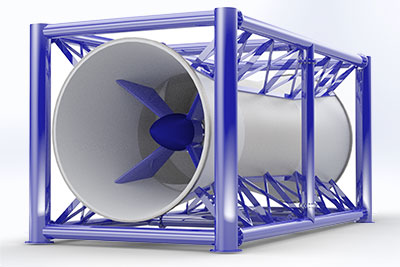FishFlow Innovations’ Free Flow Turbine makes it possible to generate clean, renewable hydro power at uniquely high efficiency. The innovative and patented design also makes the turbine fish friendly and silent. The turbine can withstand the incredible forces occurring at open sea. The revolutionary design saves on construction costs which makes it possible to generate electrical energy at a very competitive price per kWh.

The Free Flow Turbine explained
The impeller of the FishFlow Innovations Free Flow Turbine is bi-directional; it generates power when rotating clockwise as well as when rotating counter-clockwise. This means it generates electrical energy during ebb and flow when in use as a tidal turbine. The unique and patented shape of the impeller doesn’t only make the turbine fish friendly, but also makes it highly efficient. The specific shape of the impeller blades do not induce cavitation and the water leaving the impeller is released in an almost straight beam. Regardless of the speed the impeller is rotating it will not harm any fish passing through the turbine and neither will it produce noise, a hugely underestimated cause of harm to aquatic life.
Tidal power
The big advantage of a bi-directional turbine is that there is no need for the impeller blades to be flipped over when the flow direction changes. This makes the design robust, cheaper to build, cheaper to maintain and a lot less susceptible to malfunction. Also will a bi-directional turbine on average generate double the electric energy than a uni-directional turbine will generate, which only functions during ebb or flood.

- fish friendly
- bi-directional for tidal power
- low noise production
- storm proof
- low price per kWh
- easy placement (inshore and offshore)
- easy maintenance (few moving parts)
The process of development
On the images below you can see the realization of the prototype. Gerard Manshanden developed the impeller. The housing with venturi are made of glass fibre reinforced composite and the whole is surrounded by a coated steel frame. The impressive sizes of the turbine in Medemblik, The Netherlands, do not give the impression that this is only a scale model that is only 30% of the size that the final version will be. This scale model was being prepared to be installed in the Tidal Testing Centre Grevelingendam (TTC-GD). There it would have been tested on energy yield, efficiency, wear, life expectancy, sound production and fish friendliness. Unfortunately the building of the TTC-GD was never completed. The current plans are to test the scale model in the Waddenzee.
The composite turbine can be placed either inshore or offshore. Inshore placement can for example be along the shoreline, attached to bridges and in fast flowing rivers. The advantages of inshore placement are the savings on expensive power cables, the turbines are not in ship routes and can be easily accessed for maintenance. Even though they are placed near shore they are little to no horizon pollution because they can be completely submerged.
The latest designs show that future turbines for offshore purposes will get a concrete housing, which will have multiple advantages: because of their own mass there is no need for expensive foundations on the seabed and there are huge savings on steel and composite materials.
Get a quotation
Numerous tests and studies have shown that our new free flow turbine is a major innovation in hydropower development. If you are interested in this new technology, send us an e-mail at info@fishflow.nl or use our contact form.



